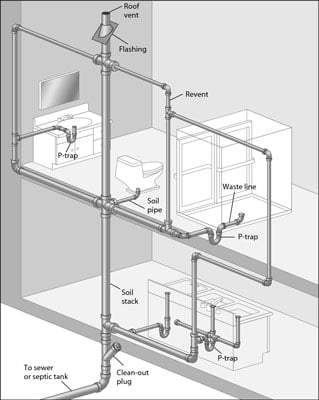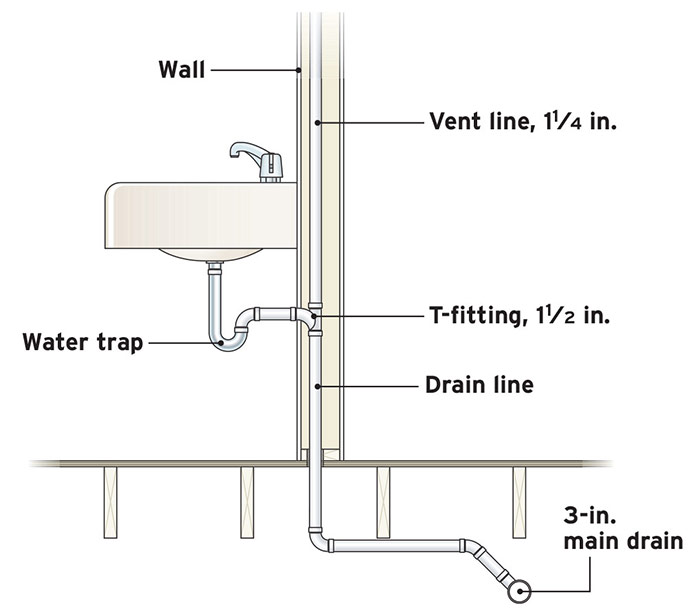Proper Ventilation in Plumbing Systems: Why It Is Essential
Proper Ventilation in Plumbing Systems: Why It Is Essential
Blog Article
What are your ideas regarding The Upsides of Proper Ventilation in Plumbing Design?

Proper ventilation in plumbing systems is often forgotten, yet it is critical for keeping the capability and safety of your home's plumbing. Ventilation assists manage air pressure, prevent the accumulation of hazardous gases, and ensure the reliable elimination of waste. In this guide, we will check out the value of proper plumbing ventilation, how it works, and the advantages it offers your pipes system.
Understanding Air Flow in Pipes
Air flow in pipes describes the network of pipelines that enable air to stream with the drainage system. These vents serve multiple purposes, consisting of managing air pressure within the pipes, avoiding sewer gases from entering the home, and assisting in the smooth flow of wastewater.
Just How Air Flow Works in Pipes Solutions
Air Pressure Guideline
Proper air flow keeps balanced atmospheric pressure within the pipes system. When water flows with pipelines, it displaces air. Without adequate ventilation, this variation can produce unfavorable pressure, resulting in slow drains pipes or siphoning of water from traps, which can create unpleasant smells to leak into the home.
Stopping Drain Gas Buildup
One of one of the most critical functions of pipes vents is to stop sewage system gases, such as methane and hydrogen sulfide, from collecting within the home. These gases can posture serious health and wellness dangers and are extremely flammable. Vent pipes allow these gases to leave securely outdoors.
Aiding in Waste Elimination
Air flow helps in the efficient removal of wastewater by protecting against airlocks in the water drainage system. When air can move freely with the vents, it allows water and waste to move efficiently via the pipelines, minimizing the risk of obstructions and back-ups.
Sorts Of Pipes Vents
Main Heap Vent
The main pile vent, additionally called the vent pile, is the primary air vent in a pipes system. It prolongs from the major drain align with the roofing system, permitting gases to escape and fresh air to go into the system.
Branch Vent
Branch vents attach to the main stack vent and offer specific fixtures, such as sinks, toilets, and showers. These vents guarantee that each fixture has adequate air flow to work correctly.
Air Admittance Shutoff (AAV).
An Air Admission Valve (AAV) is a one-way shutoff that permits air to enter the pipes system without the need for a traditional air vent pipeline prolonging through the roof. AAVs are typically utilized in improvements or locations where installing a typical air vent is unwise.
Indications of Poor Ventilation in Pipes.
Slow Draining Fixtures.
If your sinks, bathtubs, or commodes are draining pipes gradually, maybe a sign of poor air flow. Poor air circulation can create a vacuum effect, making it tough for water to drain pipes properly.
Gurgling Seems.
Gurgling noises originating from drains pipes are often a result of air being sucked with water catches as a result of adverse pressure in the pipelines. This is a clear indication of not enough ventilation.
Unpleasant Smells.
Sewage system smells inside your home are a red flag that your plumbing system is not appropriately aerated. This can mean that drain gases are not being adequately vented outside, resulting in possibly harmful problems.
Common Ventilation Errors.
Inadequate Vent Sizing.
Using undersized vent pipes can bring about poor air circulation and pressure imbalances in the system. It's vital to make use of vents that satisfy the specific needs of your pipes system.
Improper Vent Positioning.
Placing vents too much from the fixtures they offer can decrease their performance. Correct placement guarantees that air can flow freely and successfully through the system.
Disregarding Code Requirements.
Building codes supply details guidelines for pipes ventilation. Ignoring these codes can lead to a system that falls short to operate correctly and may cause costly repair work or carcinogen.
Benefits of Appropriate Air Flow.
Boosted System Efficiency.
Correctly ventilated pipes systems run more effectively, with less obstructions, faster draining pipes, and less strain on the pipes. This performance expands the life expectancy of the plumbing system.
Improved Air Top Quality.
By protecting against sewer gases from entering your home, appropriate air flow adds to much better interior air quality, making your living environment healthier and extra comfy.
Protecting Against Water Damage.
Appropriate air flow assists prevent water from being siphoned out of traps, which can lead to sewage system gases going into the home and creating water damages gradually.
Steps to Make Sure Proper Air Flow.
Consulting Plumbing Codes.
Constantly seek advice from neighborhood plumbing codes when creating or changing your pipes system. These codes provide the essential guidelines for correct airing vent and ensure your system satisfies safety and security standards.
Regular Assessment and Upkeep.
Normal examinations can aid identify potential ventilation concerns prior to they end up being major problems. Maintenance tasks, such as cleaning up vent pipelines and checking for obstructions, are vital for keeping the system in good working order.
Professional Installment.
For new installations or significant adjustments, it's a good idea to hire a specialist plumber. They have the proficiency to ensure the air flow system is correctly created and installed according to code.
Verdict.
Appropriate air flow is an important component of any type of pipes system, guaranteeing that it functions successfully and securely. By understanding the relevance of ventilation, acknowledging the indicators of inadequate air flow, and taking actions to preserve your system, you can avoid costly problems and protect your home's air high quality.
Understanding the Role of Your Plumbing Vents in the Drainage System
The plumbing system in your home is more than just the kitchen sink, toilet, and bathroom. Some problems that arise within home plumbing are hard to detect because homeowners may not understand potential causes.
One part of the plumbing system that could cause you endless problems is the venting. The drain lines that run through your home and drain wastewater need proper venting to function properly. Faulty plumbing vents can lead to several problems that require the expertise of a plumber to check them out. Before finding experienced plumbing services, there are a few things to learn about plumbing vents.
Why vents are vital
Vents in the plumbing system lead to an outside area such as the roof or the back. The function of these vents is to keep sewer gases away from the drain pipes. They also establish seals in the drainage pipes that prevent the sucking back of waste gases into the home. Venting in the plumbing system also allows oxygen to get into the drainage system, which is an essential component in the breakdown of waste matter. The vents also ensure that the air pressure within the drainage system remains balanced, facilitating the flow of wastewater.
Possible problems
When the plumbing vents are problematic, one of the consequences is imbalanced water levels in the toilet. If you notice that the levels in the toilet bowl rise and fall all the time, then there may be something wrong with the vents.
Another issue is air bubble formation within the toilet. In most cases like these, the drain pipes are not receiving enough air. Lack of air pressure equalization is what leads to water flow problems. If you come across such issues in your home, make sure you call professional plumbers, such as the ones from Perfection Plumbing & Drain Cleaning Ltd.
Potential causes
Several scenarios can lead to some of the plumbing problems that homeowners suffer because of venting. One such scenario is the use of incorrectly sized vents. Usually, vents are the same size as the drain line to facilitate proper venting. Vents that are too small will lead to some plumbing issues. Another potential cause is fixtures that are not close enough to the vents. In this scenario, air forces itself through the traps of other fixtures, leading to gurgling sounds from toilets and sinks.
Most of these problems also happen with clogged vents. Tree leaves and debris can cause clogging when they make their way down a vent. Unclogging plumbing vents is a service that you can entrust to Saskatoon plumbers. They will know how to snake down vents and remove clogging stuck in fixtures.

Hopefully you enjoyed reading our article on Essential Plumbing Vent Pipes: Understanding Their Role. Thanks a lot for taking the time to read through our post. Do you know about somebody who is serious about the topic? Please feel free to promote it. We love reading our article about What Is a Plumbing Vent and Why Is It Important.
Call Today Report this page